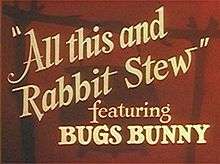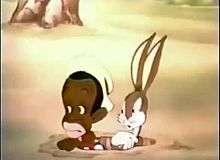All This and Rabbit Stew
| All This and Rabbit Stew | |
|---|---|
| Merrie Melodies (Bugs Bunny) series | |
 Title card. | |
| Directed by | Tex Avery (uncredited) |
| Produced by | Leon Schlesinger |
| Story by | Dave Monahan |
| Voices by |
Mel Blanc (uncredited) Danny Webb (uncredited) |
| Music by | Carl W. Stalling |
| Animation by |
Virgil Ross Robert McKimson (uncredited) Rod Scribner (uncredited) |
| Distributed by |
Warner Bros. Vitaphone |
| Release date(s) | September 13, 1941 (USA) |
| Color process | Technicolor |
| Running time | 6:39 |
| Country | United States |
| Language | English |
All This and Rabbit Stew is a one-reel animated cartoon short subject in the Merrie Melodies series, produced in Technicolor and released to theatres on September 13, 1941[1] by Warner Bros. and Vitaphone. It was produced by Leon Schlesinger and directed by an uncredited Tex Avery, with musical supervision by Carl W. Stalling
The cartoon was the final Avery-directed Bugs Bunny short to be released. Although it was produced before The Heckling Hare (after the production of which Avery was suspended from the Schlesinger studio and defected to Metro-Goldwyn-Mayer), it was released afterwards. The title is a parody of that of All This, and Heaven Too (1940), a Bette Davis for the same studio. Because the cartoon was released after Avery left Warner Bros., Avery's name does not appear in the credits.[2][3][4][5][6]
After copyright on All This and Rabbit Stew expired in 1969, the film fell into the public domain. The cartoon has been considered highly controversial due to racial stereotyping, which prompted United Artists to withhold this cartoon from syndication a year before it entered the public domain, making it one of the Censored Eleven. The plot has Bugs Bunny hunted by a slow-witted African American hunter who is a caricature of Stepin Fetchit.
Synopsis

A black hunter walks over to a rabbit hole where Bugs is eating his carrots. Bugs is led to a trunk where he tricks the hunter into destroying the tree. Bugs distracts the hunter after introducing himself, and digs underground and when the hunter realizes that Bugs has his gun. Bugs has the hunter run far enough so he can go down the rabbit hole. Realizing that he has been had, the hunter uses a toilet plunger to catch Bugs. However, Bugs tickles the hunter and flees into another rabbit hole. The hunter grabs the plunger, only to find a skunk under him. Next, Bugs lures the hunter into a cave, where they encounter a black bear. All three of them run into the rabbit hole and when Bugs and the hunter realize the bear is in the hole, they run off in fright.
Realizing that Bugs is on the hunter while walking, the hunter fires off a swarm of anthropomorphic birdshot bullets. In a madcap chase, the bullets chase Bugs into a series of holes, including a "fake" golf hole and the cave where the skunk is at. Bugs then lures the hunter into a log sitting on the edge of a cliff, through which the hunter runs numerous times (each time running to the other side as Bugs spins the log around so that the hunter keeps running off the cliff) until he falls to the ground. Bugs is confronted by the angered hunter and, in a desperate plea for his life, baits the hunter into playing what turns out to be a “strip” dice game. Bugs wins the game and walks off mocking the hunter's speech and wearing the hunter's clothes, leaving the man with a leaf covering his crotch to ad-lib “Well, call me Adam.” Bugs grabs the leaf during the "iris out".
Analysis
The film contains a reference to World War II, when the hunter threatens to Blitzkrieg Bugs.[7]
The hunter is identified in his model sheet as "Tex's Coon".[8] The hunter fills the role usually associated with Elmer Fudd; this was one of four Bugs Bunny short films of 1941 which have him facing a different hunter each time (the others were Hiawatha's Rabbit Hunt, in which Bugs faced an Indian; The Heckling Hare, in which Bugs faces Willoughby the Dog; and Wabbit Twouble, which pits Bugs against Fudd).[7] He is described as a "shufflin', big lipped, sleepy-eyed country coon". He can not resist a game of craps.[9] The Stepin Fetchit-like character has his shuffling and mumbling exaggerated for comic effect. The caricature is treated with contempt. It was clearly not a criticism of Fetchit and his stereotypical mannerisms;[8] at the time, Warner Bros. had satirized numerous celebrities of the era, regardless of race. As Fetchit's own performances were later subject to criticism from civil rights activists for portraying negative stereotypes, so too did this cartoon, eventually prompting its effective suppression.
The hunter is dressed in a hat, a short-sleeved shirt, overalls and oversized shoes. A character with the same attire and demeanor would later be used in Angel Puss (1944). He is the Sambo of the film.[10]
The hunter's and Bugs' reaction from the bear's unexpected appearance from the rabbit hole (horn sound included) was somewhat reused in Wabbit Twouble (1941).
The giant hollow log gag was reused in The Big Snooze (1946), Foxy By Proxy (1952) & Person To Bunny (1960).
Home video and television availability
Due to the film's racial stereotyping, All This and Rabbit Stew has not been seen on television since the 1990's, and is considered one of the "Censored Eleven" group of Looney Tunes/Merrie Melodies shorts. It was one of the 12 cartoons to be pulled from Cartoon Network's "June Bugs" 2001 marathon by order of AOL Time Warner on grounds of the subject material's offensiveness toward African-Americans.
It is also the only Bugs Bunny cartoon in the Censored Eleven. Due to its public domain status, it is not as scarce as most of the others. It can be seen on the internet and on low-budget video releases of public domain cartoons, in all cases as very worn-out and faded prints (neither UA nor Associated Artists Productions [a.a.p.] – from which UA had acquired the cartoons – had access to the original Technicolor negatives, which were being stored at the WB studios).
Availability
- VHS/DVD - The Censored Eleven
- VHS - Bugs Bunny And Friends
- DVD - Cartoon Craze Presents: Bugs Bunny: Falling Hare
In Popular Culture
Despite the controversy, the name of this cartoon was parodied by The Venture Bros episode All This and Gargantua 2.
Sources
- Barrier, Michael (2003). "Warner Bros., 1941-1945". Hollywood Cartoons : American Animation in Its Golden Age: American Animation in Its Golden Age. Oxford University Press. ISBN 9780198020790.
- Lehman, Christopher P. (2007). "Black Characterizations". The Colored Cartoon: Black Representation in American Animated Short Films, 1907-1954. University of Massachusetts Press. ISBN 9781558497795.
- Shull, Michael S.; Wilt, David E. (2004), "Filmography 1941", Doing Their Bit: Wartime American Animated Short Films, 1939-1945, McFarland & Company, ISBN 978-0786481699
- Stausbauch, John (2007), "Black & White Film", Black Like You: Blackface, Whiteface, Insult & Imitation in American Popular Culture, Penguin Group, ISBN 978-1101216057
See also
References
- ↑ Beck, Jerry; Friedwald, Will (1989). Looney Tunes and Merrie Melodies: A Complete Illustrated Guide to the Warner Bros. Cartoons. New York, NY: Henry Holt and Company. p. 102. ISBN 0-8050-0894-2.
- ↑ "All This and Rabbit Stew". youtube.com. Retrieved 30 October 2013.
- ↑ "All This and Rabbit Stew". imdb.com. Retrieved 30 October 2013.
- ↑ "Bugs Bunny: All This and Rabbit Stew". amazon.com. Retrieved 30 October 2013.
- ↑ "All This and Rabbit Stew (1941)". rottentomatoes.com. Retrieved 30 October 2013.
- ↑ "All This and Rabbit Stew". mubi.com. Retrieved 30 October 2013.
- 1 2 Shull, Wilt (2004), p. 100
- 1 2 Barrier (2003), p. 439
- ↑ Stausbauch (2007), unnumbered pages
- ↑ Lehman (2007), p. 58-59
External links
| Wikimedia Commons has media related to All This and Rabbit Stew. |
- All This and Rabbit Stew at The Big Cartoon DataBase
- All This and Rabbit Stew on the Internet Archive
- All This and Rabbit Stew is available for free download at the Internet Archive
| Preceded by The Heckling Hare |
Bugs Bunny Cartoons 1941 |
Succeeded by Wabbit Twouble |
